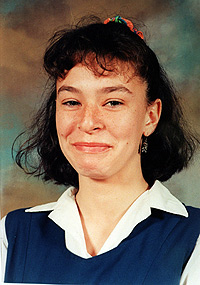Some victims of rape or other sexual violence incidents are male. It is estimated that approximately one in six men experienced sexual abuse during childhood. Historically, rape was thought to be, and defined as, a crime committed solely against females. This belief is still held in some parts of the world, but rape of males is now commonly criminalized and has been subject to more discussion than in the past.
Bernard Lefkowitz was an American author, sociologist, journalist and investigative reporter.
The Spur Posse was a group of high school boys from Lakewood, California, who used a point system to keep track of and compare their sexual attacks and statutory rapes.

Nickolas Gene Carter is an American singer and a member of the vocal group Backstreet Boys. As of 2015, Carter has released three solo albums, Now or Never, I'm Taking Off and All American, during breaks between Backstreet Boys schedules, and a collaboration with Jordan Knight titled Nick & Knight. He has made occasional television appearances and starred in his own reality shows, House of Carters and I (Heart) Nick Carter.
Glen Ridge High School (GRHS) is a comprehensive six-year public middle school / high school serving students in seventh through twelfth grades from Glen Ridge, in Essex County, in the U.S. state of New Jersey, operating as the lone secondary school of the Glen Ridge Public Schools. GRHS is accredited by the New Jersey Department of Education.
The precise definitions of and punishments for aggravated sexual assault and aggravated rape vary by country and by legislature within a country.

Cop is a 1988 American neo-noir crime suspense film written and directed by James B. Harris, starring James Woods, Lesley Ann Warren and Charles Durning. It is based on the 1984 book Blood on the Moon, by James Ellroy. Harris and Woods co-produced the film, a first for their careers.

The murder of Leigh Leigh, born Leigh Rennea Mears, occurred on 3 November 1989 while she was attending a 16-year-old boy's birthday party at Stockton Beach, New South Wales, on the east coast of Australia. The 14-year-old girl from Fern Bay was assaulted by a group of boys after she returned distressed from a sexual encounter on the beach that a reviewing judge later called non-consensual. After being kicked and spat on by the group, Leigh left the party. Her naked body was found in the sand dunes nearby the following morning, with severe genital damage and a crushed skull.

A circle jerk, also sometimes spelled circlejerk, is a sexual practice in which a group of men or boys form a circle and masturbate or touch each other's genitals. In the metaphorical sense, the term is used to refer to self-congratulatory behavior or discussion among a group of people, usually in reference to a "boring or time-wasting meeting or other event".
The Miryang gang rape, known in South Korea as the Miryang middle school girls rape incident, was a criminal incident that occurred in Miryang, South Korea in 2004. At least 44 to up to 120+ male high school students gang raped several middle school and high school girls over the course of 11 months. The case provoked controversy due to police mistreatment of the victims and lenient handling of the offenders.
The Steubenville High School rape occurred in Steubenville, Ohio on the night of August 11, 2012, when a high school girl, incapacitated by alcohol, was publicly and repeatedly sexually assaulted by her peers, several of whom documented the acts on social media. The victim was transported, undressed, photographed, and sexually assaulted. She was also penetrated vaginally by other students' fingers, an act defined as rape under Ohio law.

Rehtaeh Anne Parsons, was a 17-year-old Cole Harbour District High School student who attempted suicide by hanging at her home in Dartmouth, Nova Scotia, Canada, on April 4, 2013, leading to a coma and the decision to switch her life support machine off on April 7, 2013. Her death has been attributed to online distribution of photos of an alleged gang rape that occurred 17 months prior to her suicide, in November 2011. On a Facebook page set up in tribute to her daughter, Parsons' mother blamed the four boys who allegedly raped and released images of her, the subsequent constant "bullying and messaging and harassment", and the failure of the Canadian justice system, for her daughter's decision to die by suicide.

Audrie Taylor Pott was a 15-year-old student at Saratoga High School in Saratoga, California, who died by suicide. She had been sexually assaulted at a party eight days earlier by three 16-year-old boys she knew, and nude pictures of her were posted online with accompanying bullying.
Miles Feinstein was an American criminal law defense attorney, and legal commentator, who tried many high profile criminal cases. Miles Feinstein was called the "top Passaic County criminal defense lawyer" by the local news media. He has been practicing law in high-profile criminal cases in both New Jersey state and federal courts since 1966. He was admitted to practice in the U.S. District of New Jersey, 1967, the U.S. Court of Appeals 3rd Circuit, 1968 and the U.S Court of Appeals 2nd circuit, 1981.
Rape in Egypt is a criminal offense with penalties ranging from 15 to 25 years and a lifetime sentence if the rape included abduction. Marital rape is legal. By 2008, the U.N. quoted Egypt's Interior Ministry's figure that 20,000 rapes take place every year, although according to the activist Engy Ghozlan (ECWR), rapes are 10 times higher than the stats given by Interior Ministry, making it 200,000 per year. Mona Eltahawy has also noted the same figure (200,000), and added that this was before the revolution.
Alan L. Zegas is an American criminal defense attorney. He was born in Newark, New Jersey, received a Bachelor of Science degree from The Wharton School at the University of Pennsylvania in 1974, an MBA from The Harvard Business School in 1978, and a J.D. from Rutgers School of Law-Newark in 1981. He said that he became a lawyer to defend the “little, powerless person against the powerful forces of government.”

Sexual violence is defined as the use of force or manipulation to get someone to engage in unwanted sexual activity without his or her consent. Such violence takes place in both heterosexual and homosexual relationships, as well as outside intimate relationships. All sexual offenses violate the basic right of sexual self-determination. In Finland, sexual violence and taking advantage of a person is always a crime, even if the assaulter was the victim's spouse, relative or their friend. Sexual offences include but are not limited to rape, forcing someone into a sexual act and taking sexual advantage of a person. The victims of sexual violence are predominantly women, but 26 percent of Finnish men have experienced sexual harassment since their 15th birthday.
Mass sexual assault is the collective sexual assault of women, men and sometimes children, in public by groups. Typically acting under the protective cover of large gatherings, victims have reported being groped, stripped, beaten, bitten, penetrated and raped.
The Roxbury murders also known as “The Stride Rite Murders” occurred between January and May 1979 when eleven Black women and one White woman were murdered within several miles of one another in the Roxbury neighborhood on the south side of Boston, Massachusetts. This was not suspected to be the work of one serial killer, as at least four different men were charged on account of these murders. The Boston Globe was one of the only media outlets to cover the killings. Those most vocal about these incidents, however, were Black feminist groups, such as the Combahee River Collective, who drew connections between the violent deaths and the multiple systematically marginalized identities of the Black, female victims.
The Vanderbilt rape case is a criminal case of sexual assault that occurred on June 23, 2013, in Nashville, Tennessee, in which four Vanderbilt University football players carried an unconscious 21-year-old female student into a dorm room, gang-raped and sodomized her, photographed and videotaped her, and one urinated on her face.







